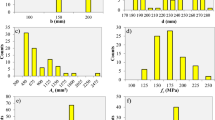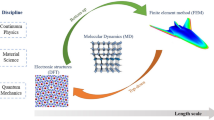Abstract
Artificial Neural Networks applied to Structural Health Monitoring (SHM) have been used to detect damage in composite structures. However, tuning the ANN architecture and its hyperparameters is difficult although fundamental for the success of ANN-based SHM models. This work proposes a new measure, the Expected Accuracy, allowing for the comparison of different general sets of hyperparameters. A new methodology to create an ensemble of architectures and to compare their performance is also proposed. The number of neurons at each layer is parameterized by polynomial functions, which are smoothly adjusted among architectures. For each topology, a set of models were independently created by randomly initializing their weights and biases at the beginning of the training phase. Then, the performance of both models and topologies can be described by the accuracy measure proposed in this work. A discussion about the impact of different compressing techniques, like PCA and LDA, is also presented in the context of ANN-based SHM using vibration data. The best performing topology reached 100% accuracy in all data sets when applied to a practical binary classification SHM problem of Glass Fiber-Reinforced Plastic composites.






Similar content being viewed by others
Data Availability
The data that support the findings of this study are available on request from the corresponding author.
References
Das M, Sahu S, Parhi DR (2021) Composite materials and their damage detection using ai techniques for aerospace application: A brief review. Materials Today: Proceedings. Int Conf Mater Process Character 44:955–960. https://doi.org/10.1016/j.matpr.2020.11.005
Toozandehjani M, Kamarudin N, Dashtizadeh Z, Lim EY, Gomes A, Gomes C (2018) Conventional and advanced composites in aerospace industry: technologies revisited. Am J Aerosp Eng 5:9–15. https://doi.org/10.11648/j.ajae.20180501.12
Oruganti K, Mehdizadeh M, John S, Herszberg I (2008) Damage detection in composites using vibration signatures., pp. 16–22
Chaki S, Harizi W, Bourse G, Ourak M (2015) Multi-technique approach for non destructive diagnostic of structural composite materials using bulk ultrasonic waves, guided waves, acoustic emission and infrared thermography. Composit Part A Appl Sci Manuf 78:358–361. https://doi.org/10.1016/j.compositesa.2015.08.033
Singh G, Aggarwal A, Kumar S, Kalra S (2022) Delamination detection and evaluation in composite laminates using guided ultrasonic waves. In: Dubey AK, Sachdeva A, Mehta M (eds) Recent Trends Indust Product Eng. Springer, Singapore, pp 47–56
Prakash R (1980) Non-destructive testing of composites. Composites 11(4):217–224. https://doi.org/10.1016/0010-4361(80)90428-0
Yu Y-H, Choi J-H, Kweon J-H, Kim D-H (2006) A study on the failure detection of composite materials using an acoustic emission. Compos Struct 75:163–169
Zhou J, Li Z (2019) Damage detection based on vibration for composite sandwich panels with truss core. Compos Struct 229:111376. https://doi.org/10.1016/j.compstruct.2019.111376
Xie B, Yao X, Mao W, Rafiei MH, Hu N (2023) High-efficient low-cost characterization of composite material properties using domain-knowledge-guided self-supervised learning. Computat Mater Sci 216:111834. https://doi.org/10.1016/j.commatsci.2022.111834
Sulaiman M, Yunus MA, Bahari AR, Abdul Rani MN (2016) Identification of damage based on frequency response function (frf) data. MATEC Web of Conferences 90:9
Das S, Roy K (2021) A state-of-the-art review on frf-based structural damage detection: development in last two decades and way forward. Int J Struct Stabil Dyn 22:1023. https://doi.org/10.1142/S0219455422300014
Nazarko P, Ziemiański L (2011) Application of artificial neural networks in the damage identification of structural elements. Comput Assist Mech Eng Sci 18:175–189
Shokry A, Espuña A (2018) The ordinary kriging in multivariate dynamic modelling and multistep-ahead prediction. In: Friedl, A., Klemeš, J.J., Radl, S., Varbanov, P.S., Wallek, T. (eds.) 28th European symposium on computer aided process engineering. Computer aided chemical engineering, vol. 43, pp. 265–270. Elsevier, New York . https://doi.org/10.1016/B978-0-444-64235-6.50047-4
Kechagias JD, Tsiolikas A, Petousis M, Ninikas K, Vidakis N, Tzounis L (2022) A robust methodology for optimizing the topology and the learning parameters of an ann for accurate predictions of laser-cut edges surface roughness. Simulat Modell Pract Theory 114:102414. https://doi.org/10.1016/j.simpat.2021.102414
Dehghani H, Zilian A (2021) A hybrid mga-msgd ann training approach for approximate solution of linear elliptic pdes. Math Comput Simulat 190:398–417. https://doi.org/10.1016/j.matcom.2021.05.036
Johansen AM (2010) Monte carlo methods. In: Peterson, P., Baker, E., McGaw, B. (eds.) International Encyclopedia of Education (Third Edition), 3rd edn., pp. 296–303. Elsevier, Oxford . https://doi.org/10.1016/B978-0-08-044894-7.01543-8
Spanier J, Azmy Y, Sartori E (2010) Monte carlo methods, pp. 117–165 . https://doi.org/10.1007/978-90-481-3411-3-3
Kingma DP, Ba J (2015) Adam: a method for stochastic optimization
Mohapatra R, Saha S, Coello CAC, Bhattacharya A, Dhavala SS, Saha S (2022) Adaswarm: augmenting gradient-based optimizers in deep learning with swarm intelligence. IEEE Trans Emerg Topics Comput Intell 6(2):329–340. https://doi.org/10.1109/TETCI.2021.3083428
Bezanson J, Edelman A, Karpinski S, Shah VB (2017) Julia: a fresh approach to numerical computing. SIAM Review 59(1):65–98
Innes M, Saba E, Fischer K, Gandhi D, Rudilosso MC, Joy NM, Karmali T, Pal A, Shah V (2018) Fashionable modelling with flux. CoRR abs/1811.01457arXiv:1811.01457
Innes M (2018) Flux: elegant machine learning with julia. J Open Source Softw. https://doi.org/10.21105/joss.00602
James G, Witten D, Hastie T, Tibshirani R (2021) An Introduct Statist Learn Applin R. Springer Texts in Statistics. Springer, New York
Bishop CM (2010) Pattern Recognition and Machine Learning, pp. 33–36. Springer, New York
Mirkes EM, Allohibi J, Gorban A (2020) Fractional norms and quasinorms do not help to overcome the curse of dimensionality. Entropy 22(10):1105
Biau G, Mason DM (2015) High-dimensional p-norms. In: Mathematical Statistics and Limit Theorems, pp. 21–40. Springer, Cham
Jolliffe IT, Cadima J (2016) Principal component analysis: a review and recent developments. Philosoph Trans Royal Soc Math Phys Eng Sci 374:20150202
Mohanty N, John AL-S, Manmatha R, Rath TM (2013) Chapter 10 - shape-based image classification and retrieval. In: Rao, C.R., Govindaraju, V. (eds.) Handbook of Statistics. Handbook of Statistics, vol. 31, pp. 249–267. Elsevier, New York . https://doi.org/10.1016/B978-0-444-53859-8.00010-2
Vaibhaw Sarraf J, Pattnaik PK (2020) Chapter 2 - brain-computer interfaces and their applications. In: Balas, V.E., Solanki, V.K., Kumar, R. (eds.) An Industrial IoT Approach for Pharmaceutical Industry Growth, pp. 31–54. Academic Press, London . https://doi.org/10.1016/B978-0-12-821326-1.00002-4
Hastie T, Tibshirani R, Friedman J (2009) The elements of statistical learning: data mining, inference, and prediction, 2nd edn. Springer, New York
Niu YS, Hao N, Dong B (2018) A new reduced-rank linear discriminant analysis method and its applications. Statist Sin 28(1):189–202
Radeç M (2001) Comparison of vibration properties | comparison of response properties. In: Braun, S. (ed.) Encyclopedia of Vibration, pp 272–277. Elsevier, Oxford . https://doi.org/10.1006/rwvb.2001.0175
Bandara R, Chan T, Thambiratnam D (2014) Structural damage detection method using frequency response functions. Structural Health Monitoring
Voltz LR, Cardoso EL, De Medeiros R (2019) Structural Health Monitoring in Mechanical Systems from Changes in Their Vibration Characteristics Based on Artificial Neural Networks and PCA. In: 25th International Congress of Mechanical Engineering (COBEM2019), Uberlândia
Lee J, Bahri Y, Novak R, Schoenholz SS, Pennington J, Sohl-Dickstein J (2018) Deep neural networks as gaussian processes. ICLR
Clevert D-A, Unterthiner T, Hochreiter S (2015) Fast and accurate deep network learning by exponential linear units (elus). ICLR2016
Martínez AM, Kak AC (2001) Pca versus lda. In: IEEE transactions on pattern analysis and machine intelligence
Acknowledgements
The authors acknowledge the financial support of the Santa Catarina State Research and Innovation Funding Agency, Brazil (FAPESC process number: 2017TR1747, 2019TR779, 2021TR843, 48/2021), Coordination for the Improvement of the Higher Level Personnel, Brazil (CAPES Finance Code 001), PROMOP (Programa de Bolsas de Monitoria de Pós-Graduação) of the Santa Catarina State University, Brazil, and the National Council for Scientific and Technological Development (CNPq), Brazil. Eduardo Lenz Cardoso acknowledges the financial support of the National Council for Scientific and Technological Development, Brazil (CNPq process number: 303900/2020-2). Ricardo De Medeiros received the financial support from the National Council for Scientific and Technological Development (CNPq process number: 304795/2022-4).
Author information
Authors and Affiliations
Contributions
Matheus Janczkowski Fogaça: Conceptualization, Methodology, Validation, Software, Writing – original draft. Eduardo Lenz Cardoso: Investigation, Validation, Writing – review & editing, Visualization. Ricardo De Medeiros: Conceptualization, Investigation, Validation, Resources, Writing – review & editing, Supervision, Project administration, Funding acquisition.
Corresponding author
Ethics declarations
Conflict of interest
The authors declare that they have no known competing financial interests or personal relationships that could have appeared to influence the work reported in this paper.
Additional information
Technical Editor: Mauricio Vicente Donadon.
Publisher's Note
Springer Nature remains neutral with regard to jurisdictional claims in published maps and institutional affiliations.
Rights and permissions
Springer Nature or its licensor (e.g. a society or other partner) holds exclusive rights to this article under a publishing agreement with the author(s) or other rightsholder(s); author self-archiving of the accepted manuscript version of this article is solely governed by the terms of such publishing agreement and applicable law.
About this article
Cite this article
Fogaça, M.J., Cardoso, E.L. & de Medeiros, R. A systematic approach to find the hyperparameters of artificial neural networks applied to damage detection in composite materials. J Braz. Soc. Mech. Sci. Eng. 45, 496 (2023). https://doi.org/10.1007/s40430-023-04371-y
Received:
Accepted:
Published:
DOI: https://doi.org/10.1007/s40430-023-04371-y




